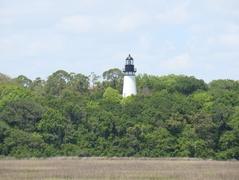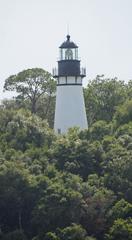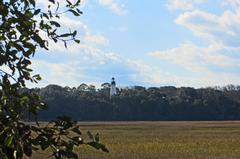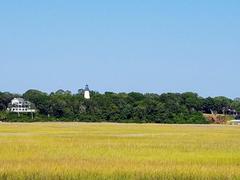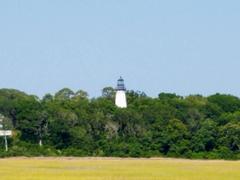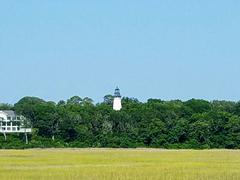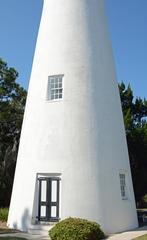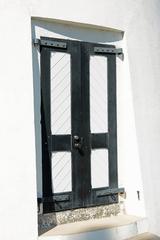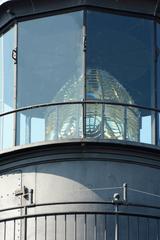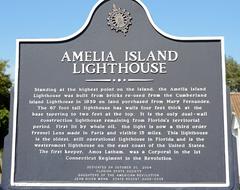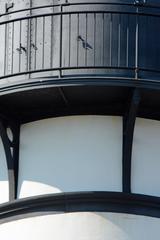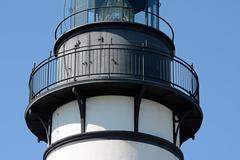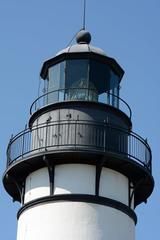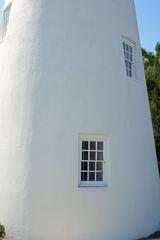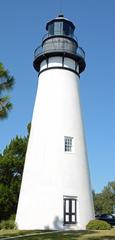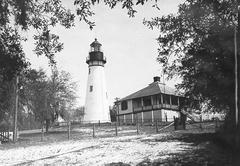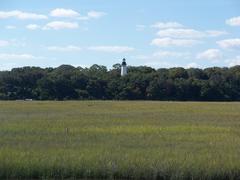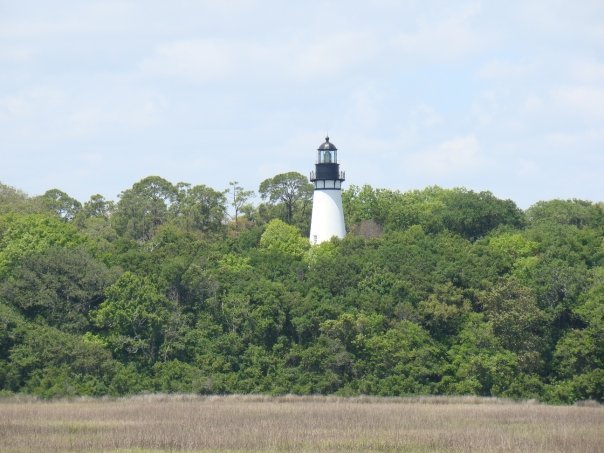
Visiting Hours, Tickets, and Historical Sites of Amelia Island Light in Fernandina Beach
Date: 25/07/2024
Introduction
The Amelia Island Lighthouse, located in Fernandina Beach, Florida, is a historic maritime beacon that has stood the test of time. As the oldest existing lighthouse in Florida, it holds a unique place in the state’s rich nautical history. Originally constructed on Cumberland Island in 1820, the lighthouse was moved to Amelia Island in 1838 to better serve the navigational needs of ships entering the St. Mary’s River. This guide offers a comprehensive look at visiting the Amelia Island Lighthouse, covering its historical significance, architectural features, visiting hours, ticket information, and travel tips. Whether you are a history buff, a maritime enthusiast, or a curious traveler, this lighthouse is a must-visit landmark that provides a glimpse into the past and the evolution of maritime navigation (Amelia Island Lighthouse, Wikipedia).
Table of Contents
- Introduction
- History of Amelia Island Lighthouse
- Visiting the Amelia Island Lighthouse
- Notable Keepers
- Preservation and Public Access
- Significance and Legacy
- Conclusion
History of Amelia Island Lighthouse
Early Beginnings and Construction
The Amelia Island Lighthouse, standing as the oldest existing lighthouse in Florida, has a rich history that dates back to the early 19th century. Initially, a lighthouse was constructed on Cumberland Island in 1820 to guide ships safely into the St. Mary’s River and along the Atlantic Coast. However, the shifting channels soon rendered the Cumberland Island Lighthouse ineffective. In response, Congress allocated $7,500 in 1838 to dismantle the original structure and transport it across the river to Amelia Island. The lighthouse was reconstructed on the northern end of Amelia Island using the original materials (Amelia Island Lighthouse).
Design and Features
The Amelia Island Lighthouse was built by Winslow Lewis and features a brick double-walled tower with a metal cupola. Initially, it was equipped with fourteen oil lamps, each backed by a 14-inch reflector to produce a distinctive flashing pattern. By 1848, the reflector size was increased to 15 inches. In 1903, the original oil lamps were replaced with a third-order Fresnel lens, a marvel of engineering that remains operational to this day (Amelia Island Light). The lighthouse stands 64 feet tall, with a focal plane height of 107 feet above sea level. The light signature is one flash every ten seconds, with a red sector in the southeast quadrant to warn mariners of shoals in that area (Amelia Island Lighthouse).
Civil War and Technological Advancements
The turmoil of the Civil War briefly dimmed the lighthouse’s guiding light in 1861. Despite the conflict, the tower emerged relatively unscathed and quickly returned to service. Each day, the head keeper ascended the sixty-nine granite steps, oil buckets in hand, to tend to the light that guided ships through the darkness (Amelia Island Lighthouse). In 1903, the lighthouse underwent a significant technological transformation with the installation of a third-order Fresnel lens. This advancement allowed for a more powerful and efficient light, which continues to guide seafarers to this day. The arrival of electricity in the 1930s further modernized the lighthouse, leading to its automation in 1970 (Amelia Island Light).
Visiting the Amelia Island Lighthouse
Visiting Hours and Ticket Information
The Amelia Island Lighthouse is not open to the public except on Saturdays when the grounds are open for viewing from 11:00 am to 2:00 pm. For access inside the lighthouse, visitors must register for a tour through the Atlantic Recreation Center (Amelia Island Lighthouse). Tours of the lighthouse are held on the first and third Wednesdays of each month. The tour fees are $10 per adult and $5 per child ages 12 and under, with a minimum participation of 5 people and a maximum of 22 people. However, the tour does not allow patrons to climb the stairs inside the lighthouse (Amelia Island Lighthouse).
Travel Tips
When planning your visit to the Amelia Island Lighthouse, consider arriving early to fully enjoy the picturesque surroundings. Comfortable walking shoes are recommended, and don’t forget your camera to capture the stunning views and historical architecture. The lighthouse is located in Fernandina Beach, a quaint town with various historical sites and local eateries, perfect for a day trip.
Nearby Attractions
Fernandina Beach offers a plethora of attractions for visitors. Explore the historic district, visit the Fernandina Beach Museum, or take a leisurely stroll through Fort Clinch State Park. The area’s rich history and vibrant community provide plenty of activities to complement your lighthouse visit.
Accessibility
The lighthouse grounds are accessible but may present challenges for those with mobility issues due to uneven terrain and steps. It’s advisable to contact the Atlantic Recreation Center in advance to discuss any specific accessibility needs.
Notable Keepers
The lighthouse has had several notable keepers over the years. The next-to-last civilian keeper was Thomas J. O’Hagan, who was the son of the previous keeper, Thomas P. O’Hagan, and was married to a direct descendant of the first keeper, Amos Latham. The dedication and service of these keepers played a crucial role in maintaining the lighthouse’s operation and ensuring the safety of mariners (Amelia Island Light).
Preservation and Public Access
Today, the Amelia Island Lighthouse stands as a testament to Florida’s maritime heritage and the timeless allure of the sea. In 2001, the City of Fernandina Beach received possession of the lighthouse from the U.S. Coast Guard. The Coast Guard, with the help of local Coast Guard Auxiliary volunteers, continues to be responsible for the function of the beacon. The City of Fernandina Beach is committed to preserving this historical monument, recognizing its importance as one of the island’s most visible and beloved historic sites (Amelia Island Lighthouse).
Significance and Legacy
The Amelia Island Lighthouse remains a significant historical landmark, symbolizing the enduring spirit of maritime tradition. Its light, which can be seen as far as 16 miles out to sea, continues to guide seafarers safely into the channel toward Fernandina Harbor. The lighthouse’s rich history and technological advancements reflect the evolution of maritime navigation and the importance of preserving such historical monuments for future generations (Amelia Island Lighthouse).
Conclusion
The Amelia Island Lighthouse stands not just as a navigational aid but as a monument to the history and culture of maritime life in Florida. Its enduring light, which has guided countless vessels safely to shore, remains a symbol of hope and resilience. Today, the lighthouse continues to draw visitors who are eager to explore its storied past and architectural beauty. By preserving this historical site, Fernandina Beach ensures that future generations can appreciate the technological advancements and the human stories that have shaped its legacy. Whether you are visiting for its historical significance, its picturesque surroundings, or its unique place in maritime history, the Amelia Island Lighthouse offers a rich and rewarding experience (Amelia Island Lighthouse, Lighthouse Friends).
References
- Amelia Island Lighthouse, 2023, Amelia Island source
- Amelia Island Light, 2023, Wikipedia source
- Amelia Island Lighthouse, 2023, U.S. Lighthouses source
- Amelia Island Light, 2023, Lighthouse Friends source
- Things to Do Amelia Island Florida, 2023, Southern Living source
- Planning a Trip to Amelia Island, 2023, History Fangirl source
